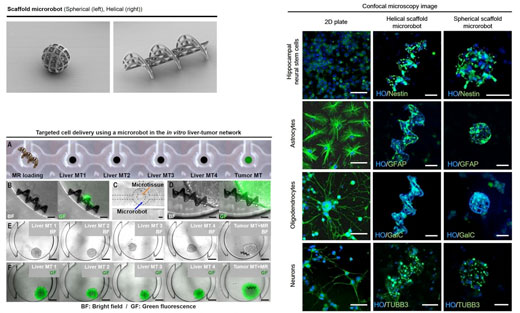| Jun 17, 2019 | |
Stem cell transplantation with scaffold microrobots(Nanowerk News) A DGIST (Daegu Gyeongbuk Institute of Science and Technology) research team succeeded in developing stem cell delivery of scaffold microrobots that can precisely deliver cells to a target body tissue (Science Robotics, "Magnetically actuated microrobots as a platform for stem cell transplantation"). |
|
| This research achievement is expected to enhance the treatment safety and efficiency of degenerative neural disorders as it can precisely transplant the exact amount of stem cell-based treatment cells to human body tissues and organs. | |
| A joint international research was conducted with Senior Researcher Jin-young Kim at DGIST-ETH Microrobot Research Center, Professor Seong-Woon Yu and Professor Cheil Moon's team in the Department of Brain and Cognitive Sciences, Professor Sung Won Kim's team in Seoul St. Mary's Hospital, and Professor Bradley J. Nelson's team in the Institute of Robotic and Intelligent Systems at ETH, Zurich, Switzerland. | |
| Stem cell treatment has been taking the limelight as a regenerative medical technique for intractable disorder treatment, but it cannot transplant the exact amount of stem cells to the target areas in need of treatment deeply inside body or may carry injection risk. It has especially been pointed out that treatment efficiency and safety are low due to huge loss during the in vivo delivery of stem cells and a high cost of treatment. | |
| To overcome such limitation, the DGIST research team devised a scaffold microrobot in a spherical and helical type through 3D laser lithography. The biggest achievement of this study is that it minimized cell loss in the body through a wireless control method using an external magnetic field while transplanting stem cells quickly and precisely at the same time. | |
 |
|
| 1) Image of scaffold microrobot – Spherical (left), Helical (right). 2) Result by culturing hippocampal neural stem cell in 3D on a microrobot cell and selectively dividing them into astrocyte, oligodendrocyte, and neuron. 3) Result of target cell transfer and transplantation using microrobot inside Body-on-a-Chip (BoC), a microfluidic cell multiple culture system that can form and culture the connection network of multiplex fine organ that replicated an in vivo environment. (Image: DGIST) (click on image to enlarge) | |
| What is noteworthy is that while the existing researches tested microrobots in a static external environment and not physiological environment, this research cultured a hippocampal neural stem cell on a microrobot for the first time. They divided the cell into specific cells such as astrocyte, Oligodendrocyte, and neuron and succeeded in precisely delivering and transplanting them in the target. | |
| To gain this achievement, the research team showed the cell transfer and transplantation process using the microrobot inside Body-on-a-chip (BOC), a microfluidic cell culture system that replicated a physiological in vivo environment. They also extracted a rat's brain and injected the microrobot into the internal carotid artery, and transferred it to the anterior cerebral artery and middle cerebral artery using outer magnetic field. | |
| A highlight of this joint research is that they cultured the human nasal turbinate derived stem cells (hNTSCs) provided by Professor Sung Won Kim's team at the Catholic University St. Mary's Hospital on the microrobot in 3D for successful experiment. | |
| Professor Hongsoo Choi at the Department of Robotics Engineering said "Through this research we hope to increase the treatment efficiency and success rate for Alzheimer and central neural diseases, which couldn't be approached through the existing method of stem cell treatment. Through continuous follow-up research with hospitals and related companies, we will do our best to develop a microrobot-based precise treatment system that can be used in actual hospital and clinical sites." |
| Source: DGIST (Daegu Gyeongbuk Institute of Science and Technology) | |
|
Subscribe to a free copy of one of our daily Nanowerk Newsletter Email Digests with a compilation of all of the day's news. |
